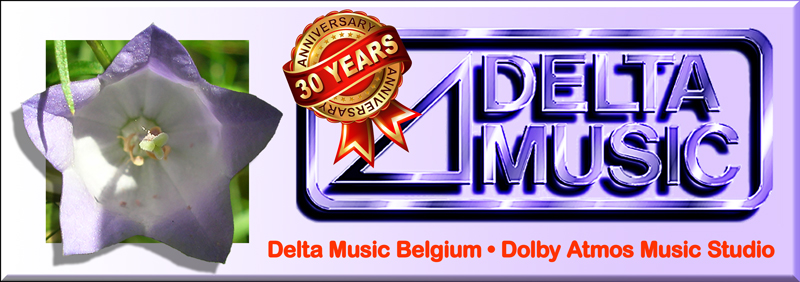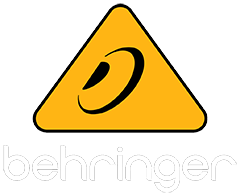News archive 2017
![]()
December 02, 2017
![]()
New virtual instrument for the
ROLI Seaboard RISE 49:
SWAM based multi-vector expressive acoustic instruments emulations

Since I bought my ROLI Seaboard RISE 49, I am constantly looking for software that is specifically suited to use with this wonderful keyboard. This concerns software that can handle the MPE protocol and the 'Five Dimensions of Touch' of the Seaboard. The ROLI Seaboard RISE 49 comes with the ROLI Equator software synthesizer and it is very good, but unfortunately very limited in terms of imitating acoustic sounds such as string and wind instruments.
Even before the purchase of my Seaboard I already knew that the company Audio Modeling from Italy was very progressive in the field of 'physical modeling'. They have developed the SWAM engine, this stands for 'Synchronous WAVES Acoustic Modeling'. This technology is not based on the playback of samples, but on mathematical models of acoustic struments, just like my Roland V-Piano.
I started very carefully with just the purchase of the 'Cello' and I was immediately very enthusiastic about the realistic nature of this virtual instrument when played with my Seaboard. Soon I also bought the 'Viola' and 'Violin' and I was immediately very satisfied. These SWAM string instruments are actually already a further evolution of the SWAM engine, because they work with SWAM-S engine, actually the extra 'S' stands for 'strings'. The original SWAM engine has been around for a longer time and was originally developed for imitating wind instruments. The original SWAM wind instruments are also available and in the meantime I have also bought this entire collection.
All these virtual instruments are of course monophonic solo instruments because you can not play chords on a wind instrument. Only with the string instruments there is the possibility to play 2 adjacent strings at the same time, but this is limited to only what is possible on real string instruments.
Sonow available at Delta Music Belgium (in the wind instruments you just see one of the available instruments from each available instrument group):
Audio Modeling - SWAM Engine - wind instruments
Clarinets
Double Reeds
Flutes
Saxophones
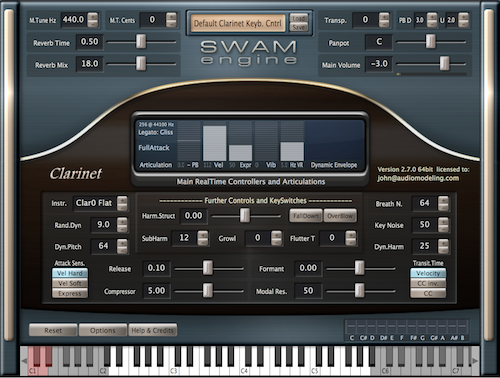


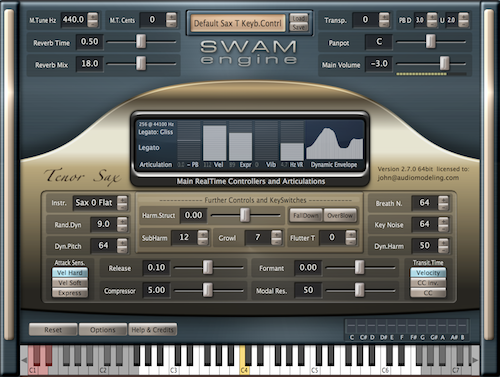
Audio Modeling - SWAM-S Engine - string instruments
Double Bass
Cello
Viola
Violin
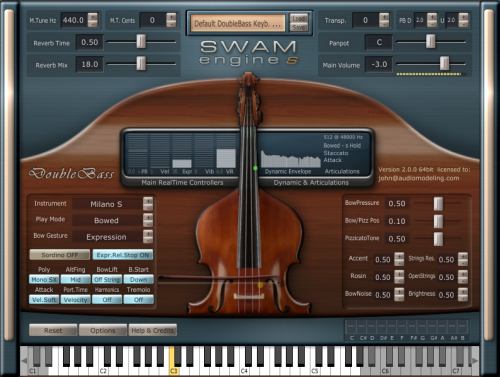
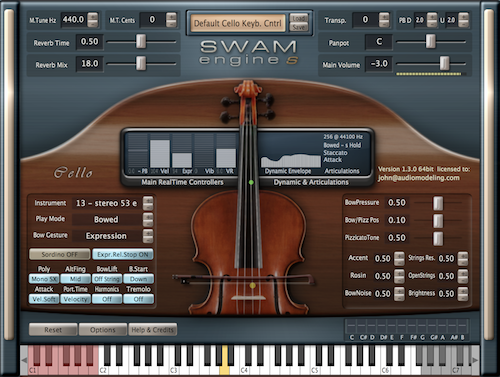
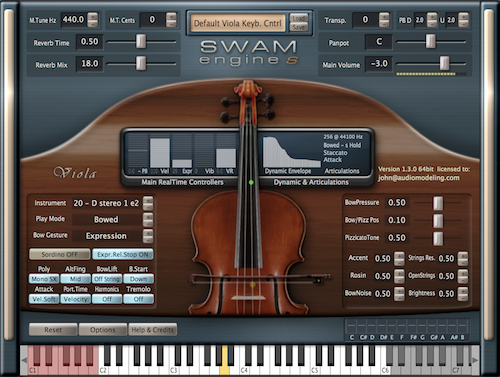
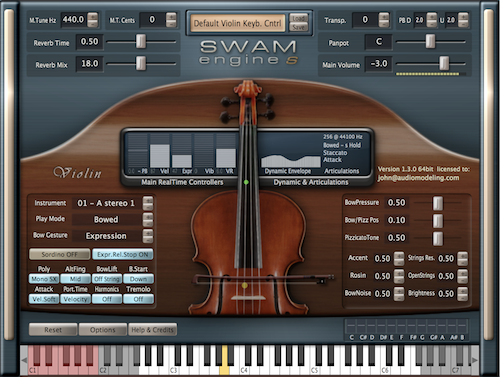
![]()
November 09, 2017
![]()
Surfing on the WAVES of my
ROLI - Seaboard RISE 49

In my post of August 22, 2017 I wrote about the ROLI Seaboard RISE 49 and meanwhile I have this special keyboard for more then 2 months in my possession, along with some extra MPE compatible software.
Does this keyboard really live up to what it promises? In short, the answer to this question is a resounding 'yes'.
Of course it takes some time to adapt to the special playing feel of the silicone 'keyWAVES', but ultimately it went much smoother than expected. You just have to experiment as much as possible with the 'Five Dimensions of Touch' and not play as you would on a standard piano keyboard. The intention is to press, slide, release keys quickly or slowly, it all has its influence on the MIDI synthesizer software that you are controlling.
But in the meantime it also appears that quite a few of my hardware synthesizers can partially or completely receive and process the MPE protocol, provided that the necessary MIDI controllers are assigned to the correct parameters. As a result, some synthesizers have shown a whole new world in terms of expression and character that could only be achieved by moving the sticks, wheels and knobs separately (which of course is not possible if you play with two hands). Now you can control all of this with just the movements of your fingers on the keyWAVES, very beautiful! From very subtle to very expressive, it is literally immediately available under every fingertip.
The result is that I will almost always choose to play a software or hardware synthesizer with the ROLI Seaboard RISE 49 now and only if it appears t be that this can add little or nothing extra I will use a standard MIDI keyboard with ordinary piano keys.
Overall, I consider my ROLI Seaboard RISE 49 to be the best and most innovative investment I've made in the last 10 years + it has made my way of making music much more intuitive due to the 'Five Dimensions of Touch' that makes every nuance and expression instantly available. just like an acoustic string or wind instrument.
![]()
October 26, 2017
![]()
New acquisition in the studio:
![]()
![]()
iConnectivity
mio10 - MIDI Interface (x2)
When I first installed MacOS Sierra 10.2.6 on one of the SSDs on the studio computer 2 months ago, I came to the unfortunate conclusion that my MIDI interface suddenly did not work anymore. This was a digidesign MIDI I/O from 2006 that still works perfectly on all previous versions of the MacOS.
At the same time it turned out that of the 3 connected QWERTY keyboards + trackballs, 1 set did not work anymore. I also discovered that some hardware synthesizers connected to the studio computer via USB for their MIDI communication did not appear in the Audio MIDI Setup anymore (while they are 'MIDI class compliant' and therefore do not need their own MIDI drivers). However, if I restarted with an older MacOS, the whole studio worked fine as it always did, therefore the cause had to be found in MacOS Sierra.
After looking at Apple Support pages for a possible cause and experimenting and testing a lot by myself, I finally discovered that Apple has adapted the USB 2.0 protocol to the much stricter USB 3.0 protocol in MacOS Sierra. In theory, USB 3.0 is 100% backwards compatible with USB 2.0, but in practice it appears to be that the number of USB devices that can be connected is drastically reduced on older Macs with only USB 2.0 connections.
I had 6 USB hubs with 7 USB 2.0 ports each connected to my old, faithful Mac Pro (with USB hubs connected to USB hubs) + some USB repeater cables and for MacOS Sierra this was apparently too much to handle. When I disconnected about half of all connected USB devices it usually went well more or less, but this was obviously not a useful solution.
After a long search, I then found the Canadian company iConnectivity, which has the mio10 MIDI interface available in their product range. This is the most comprehensive MIDI interface on the market with, among other things, 10 MIDI DIN ports and the unique possibility to also connect MIDI class compliant devices This is the most comprehensive MIDI interface on the market with, among other things, 10 MIDI DIN ports and the unique possibility to also connect 10 MIDI class compliant devices directly to the mio10 by USB via an USB hub.
To make a long story short, I finally succeeded in connecting all my hardware MIDI instruments to 2 iConnectivity mio10s,either via USB or via MIDI DIN ports (this is for devices that do not have USB or USB that is not 'MIDI class compliant'). In this way I now have just 2 USB connections on the Mac Pro in use for all MIDI communication and MacOS Sierra seems to be satisfied by that. Additional advantages are that my USB cabling has become much more symplified (and is therefore also more reliable) and it also works fine on previous versions of the MacOS.
But for the sake of completeness, I also have to add that an iConnectivity mio10 is a very complex device with very many connection options:
- 10 x MIDI DIN connectors for hardware synthesizers without USB
- 10 x MIDI USB connections via an USB hub for hardware synthesizers with USB
- 4 x Network MIDI via an Ethernet connector
- 2 x USB for simultaneous use of 2 different host computers
In total there are no less than 56 MIDI buses available, each with 16 MIDI channels for each MIDI bus + there are also programmable MIDI filters + full MIDI routing. And to make it even more complicated: out of the box all the inputs are connected to all outputs, so first you have to program the machine correctly until all MIDI data follows the correct path from each hardware synthesizer to the computer and back (and I then had to program 2 mio10s).
It took almost 2 months to get everything working and on the one hand this is due to the fact that I have a very large MIDI setup. But on the other hand the manual is very limited and you have to be very patient when mailing to iConnectivity for support. (waiting 2 or 3 weeks for an answer was no exception).
In summary, the iConnectivity mio10 MIDI interface is called the Rolls-Royce among the MIDI interfaces for a reason and I am very satisfied with how well and streamlined everything works now. But it is certainly not easy, so-called 'plug-and-play' really does not apply here.
![]()
August 22, 2017
![]()
New acquisition in my collection hardware synthesizers and MIDI controllers:

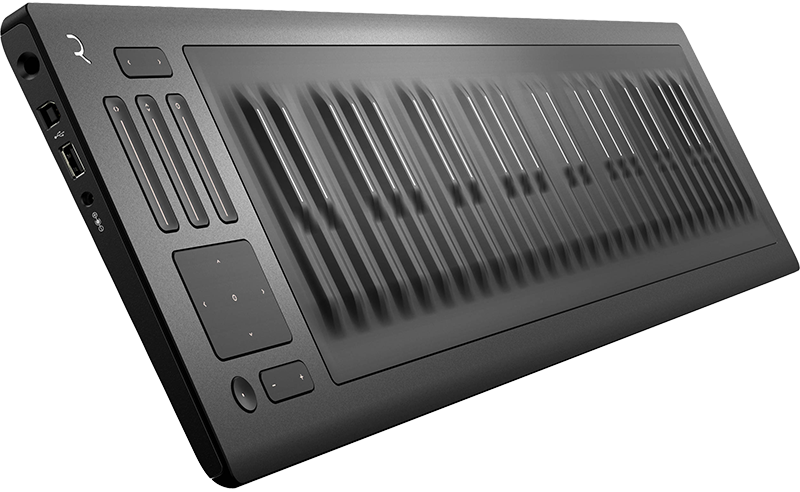
ROLI - Seaboard RISE 49

Control Sound with Five Dimensions of Touch
A standard keyboard such as on a piano, organ or synthesizer actually does not have many expressive possibilities. Depending on the instrument, you can only play the keys with hard and soft touches andmaybe add some vibrato or other limited expression possibilities by manipulating pedals, knobs and wheels...
The expression as possible with a violin or guitar and most wind instruments is very difficult to replicate realistically with a standard MIDI keyboard. With the necessary sound libraries it is possible, but it requires a lot of editing of the recorded MIDI data in your DAW afterwards to imitate all nuances in detail (usually by drawing additional MIDI controller data on the screen).
There are of course MIDI violins, MIDI guitars and MIDI wind instruments that send MIDI controller data resulting in very realistic expression possibilities. But there the problem is that you first and foremost have to be able to play violin, guitar or saxophone very well to achieve acceptable results. And you can also ask yourself the question whether it is not much easier just to record the real sound of the instruments with microphones instead of controlling a digital imitation of that same instrument via MIDI. Incidentally, these MIDI instruments were not designed to imitate themselves anyway, they were designed to control electronic instruments via MIDI such as synthesizers, samplers and virtual instruments. Or to put it differently: someone who cannot play a keyboard can still play piano or synthesizer sounds with his MIDI instrument, and most of the time with more expression possibilities than possible with a standard MIDI keyboard.
It is here where ROLI makes the difference, because in a few words a Seaboard RISE is a mix between standard MIDI keyboard and a violin. The classical piano keys have been replaced by a wave-like structure made of silicone (called 'keyWAVES' + the name 'Seaboard' was also derived from this) and the entire playing surface is sensitive to positioning and pressure.
Hence also the term 'Five Dimensions of Touch' which are subdivided into:
- Strike: keywave keystrokes and this corresponds to MIDI CC 'velocity' (like playing soft or hard on a piano key)
- Glide: horizontally moving your finger on a keywave for vibrato and glissando and corresponds to MIDI CC 'pitch bend'
- Silde: moving your finger vertically on a keywave for eg opening a filter or switching to another sound (eg a piano sound that gradually changes into a trumpet) and corresponds to MIDI 'polyphonic aftertouch'
- Press: pressing the playing surface for, for example, the swelling of a sound corresponds to MIDI 'channel pressure' (or 'monophonic aftertouch')
- Lift: the speed of releasing a keywave (eg quick release cuts off the sounding note, slow release causes the sounding note to fade out) and corresponds to MIDI CC 'release velocity'
Actually, the keyWAVES serve only as a reference to a piano keyboard because the movements of each finger over the entire playing surface are detected separately and transmitted via USB MIDI. This is done over 14 separate MIDI channels so that each finger separately has the complete 'Five Dimensions of Touch' available. This way of using MIDI is becoming known under the name 'Multidimensional Polyphonic Expression' or MPE. The ROLI Equator software synthesizer also comes with a ROLI Seaboard RISE 49. This is a very extensive synthesizer and sound engine that was specifically designed for MPE and works seamlessly with a Seaboard.
In short, it is the combination of the entire playing surface that is sensitive to positioning and pressure + the new MPE protocol + the ROLI Equator software synthesizer that makes the ROLI Seaboard RISE 49 an extremely expressive instrument.
But other software manufacturers are also coming up with MPE compatible software, including virtual instruments that give a very realistic imitation of, for example, a violin, guitar or wind instrument with all the extensive expressive possibilities that come with it.
The future will now have to show whether this exceptional instrument actually does what it promises...
![]()
June 24, 2017
![]()
New acquisition to my synthesizer collection:

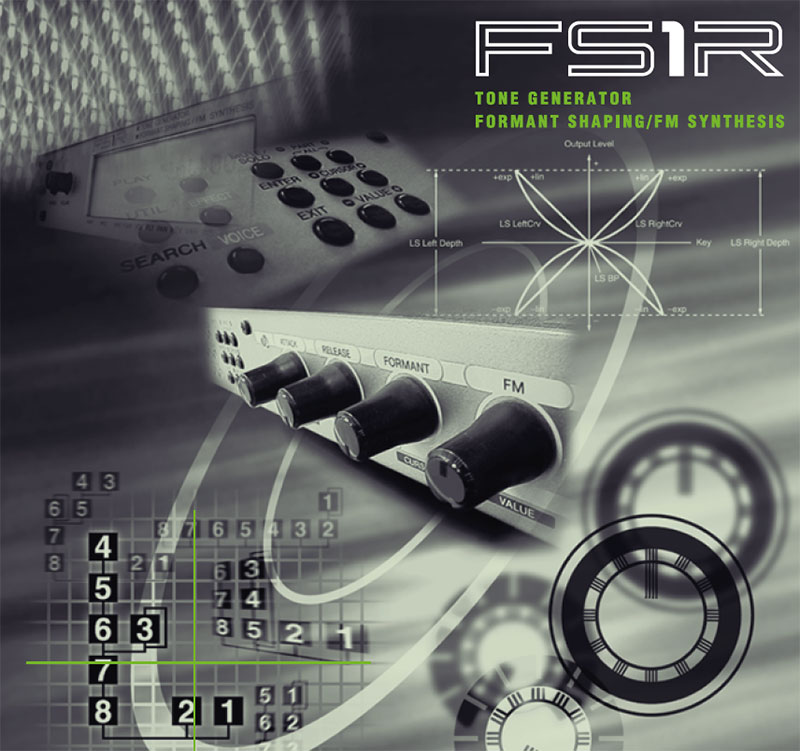

YAMAHA - FS1R -
Tone Generator
Formant Shaping/FM Synthesis
For many years, I know there is an essential way of sound generation that is completely lacking in my collection of synthesizers. All synthesizers Iown are based in one way or another on subtractive sound synthesis. Simply explained, this works as a sculptor makes an image: you start with a stone and you chop away until the desired result is reached: the sculpture. In subtractive sound synthesis, this works just the same: you start with a complex sound wave and you remove frequencies until what remains is the desired sound.
However, there is also a fundamental opposite way of performing sound synthesis and that is additive synthesis. This can be compared to a molder: You start with an empty plane and add the booty clay until the desired result is reached: the sculpture. Inadditive sound synthesis, this is also works just the same: you start out with absolute silence and you add simple sound WAVES to each other and cause them to interfere until you reach the desired sound. This form of sound synthesis is based on the Fourier analysis in mathematics that is being applied to sound and states that each sound can be traced down to a set of simple sinus WAVES interfering with each other. Thus, conversely, by adding up x-number of sinus WAVES and you let them interfering with each other, in theory, you can generate any conceivable type of sound.
This additive synthesis based on the Fourier analysis was developed by YAMAHA in the 1970s and was called 'FM synthesis' (frequency modulation synthesis). The first synthesizer based on this was the legendary YAMAHA DX7 from 1983.
This is a picture of a YAMAHA DX7:
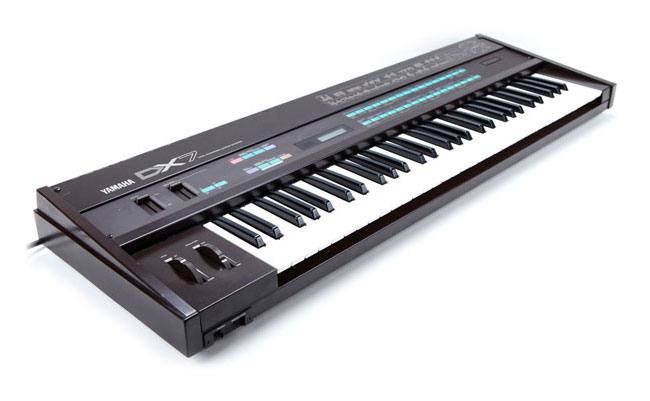
After the DX7 followed a whole series of successors, versions with a keyboard and in the form of a 19" rack module, bv. DX7II, SY77, SY99, TX7, TX81Z, TX802, TG77, de volledige DX-reeks die later kwam met bv. de DX100 en DX200, enz...
The latest synthesizer with FM synthesis that was released was the YAMAHA FS1R module in 1998. But this module had little success because musicians were not that excited anymore about FM synthesis. Other manufacturers who released synthesizers during that period were much more innovative, so after a year and a half the FS1R was taken back from the market and the stocks were sold at bottom prices. To be complete: YAMAHA has recently recovered FM synthesis in the new range of YAMAHA MONTAGE workstations under the name FM-X.
For a long time I played with the idea of buying a YAMAHA synthesizer with FM synthesis, but I've never been a big fan of the DX7 and all its successors + I have never really tracked the gamma of YAMAHA FM synthesizers. A few weeks ago, however, I saw an interesting offer for a second hand YAMAHA TG77. This is the module version of the SY77 and is known for being a very good FM synthesizerr. I started to learn more about this module and to my great surprise, the overall conclusion was that a TG77 is indeed a good FM synhesizer, but does not come close to a YAMAHA FS1R. This module has the most extensive FM generator that YAMAHA has ever designed + it also sounds better than all older FM synthesizers. The FS1R also has all DX7 sounds available as presets, including all the sounds available on the DX7 cartridges.
Frankly, I had never heard of the YAMAHA FS1R module and after some online research I soon found out that this synthesizer has achieved a true cult status. And this not only for its extensive FM synthesis but also because this module has 'Formant Shaping Synthesis'. In summary, Formant Shaping synthesis is able to synthesize voice-like sounds, you could say that this synthesizer can speak. But for all clarity: it's not a classic vocoder where you connect a microphone, It is the module itself that more or less imitates the human voice.
The combination of FM synthesis and Formant Shaping synthesis makes this synthesizer truly unique. On the one hand, the FM synthesis in this module is the most comprehensive ever and goes a lot further than the DX7, on the other hand, the Formant Shaping synthesis is combined with the FM synthesis which leads to unprecedented possibilities.
However, there is one disadvantage: this synthesizer has thousands of parameters that all need to be checked and programmed via a few pushbuttons and a small green screen. This makes the FS1R really a synthesizers that is not user friendly at all and this also partly explains further why it has never really been popular. The analoguey most used for programming sounds on an FS1R is that you would try to paint the ceiling of the Sistine chapel in the Vatican in Rome through the keyhole of the chapel's door. So you absolutely need an editor on a computer to program this synthesizer.
In summary, It was soon clear to me that the YAMAHA FS1R is actually the ideal way to finally also have FM synthesis available in the studio. Because it's a small but very powerful FM synthesizer that sounds very good + the presence of Formant Shaping synthesis makes it complete and unique + this module is so rare that it has also achieved a true cult status, what else do you want...
I then searched the web for a second-hand machine and I've found exactly three machines up for sale worldwide, one of which was in Belgium. This was also the cheapest one of the three, so I did not hesitate and bought it immediately.
I have the module in the studio for a few days now, If I had to describe the sound in a few words, then it's 'creepy' and 'ice cold' but also 'warm' and 'full'. Of course, the classic warm FM sounds from the DX7 sound very familiar (The typical FM electric pianos, organ sounds and brass), But once you leave this well-known path, you'll soon find yourself in a strange world with soundscapes that make your hair stand on end. One moment you walk alone over a dead planet in a solar system far far away in the galaxy (ice cold FM synthesis for advanced sound designers), A little later, a mysterious door is being opened to a very ominous place with a presence that once was human (FM synthesis combined with Formant Shaping synthesis). It is, of course, a machine of 1998, so it's not really all that innovative, But in my collection of synthesizers, this module fills a separate space with a sound palette that is not available in any of my other synthesizers.
So from now on available in the studio: a YAMAHA FS1R with a unique combination of very extensive FM synthesis and Formant Shaping synthesis.
I just hope I will not get a headache if I want to program new sounds on that small green screen (but I have already found a decent editor for Mac).
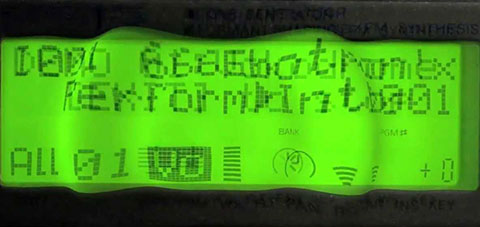
![]()
June 08, 2017
![]()
New acquisitions to my synthesizer collection:


YAMAHA - 01V96i - Digital Mixing Console
A mixing console in my synthesizers collection? Exactly, because this new digital mixing console serves only serves in the studio to connect synthesizers and the like and forward the signals digitally to Pro Tools HD hardware or to the Apple Mac Pro computer.
Actually, I already have a long history of working with YAMAHA digital mixing tables, because already in 1994 I bought a YAMAHA Programmable Mixer 01. A few years later I bought a 2nd machine to expand the first one, but then YAMAHA already changed (abbreviated) it's name to YAMAHA ProMix 01. However, I do not have them anymore because they were completely worn (eventually I brought them to the recycling park).
This is a picture of a YAMAHA ProMix 01:
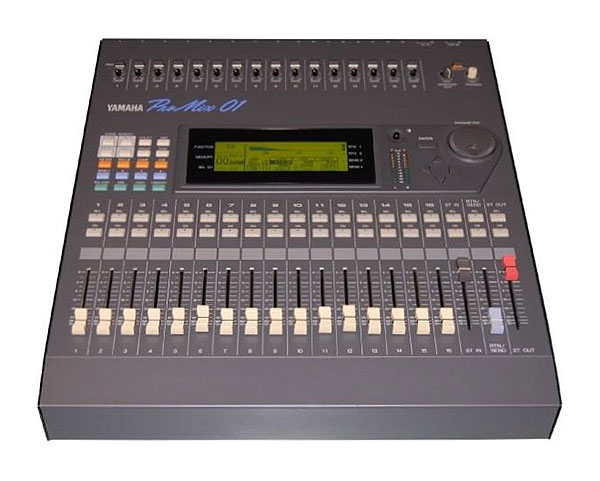
By the year 2000, both ProMix 01 mixing tables were replaced by a YAMAHA 03D because my entire studio became full 24 bit capable and the ProMix 01 could only work with 16 bit signals. BTW, the 03D is the smaller brother of the legendary YAMAHA 02R Digital Mixing Console.
Until last week, I still used my old faithful YAMAHA 03D, but it has long bothered me that the maximum sample frequency of a 03D just 48 kHz while my studio has been operating at 96 kHz since 2005. This is not a real big problem as 48 kHz can easily be up-sampled to 96 kHz but also the limited number of inputs and outdated technical capabilities became a problem. And after using the 03D for more than 15 years, it was recommended to replace this machine anyway (but it remains present in the studio to serve as an extra digital mixing console if necessary)
This is a picture of a YAMAHA 03D:

Because I'm so happy about YAMAHA digital mixing consoles it is therefore a logical choice to replace the 03D with its successor, the YAMAHA 01V96i. Although a 01V96i is actually the 4th version that YAMAHA has released on the market because in 1998 the 01V came on the market, in 2003 the 01V96, in 2008 the 01V96 VCM and in 2011 the 01V96i.
This is a picture of a YAMAHA O1V96i:
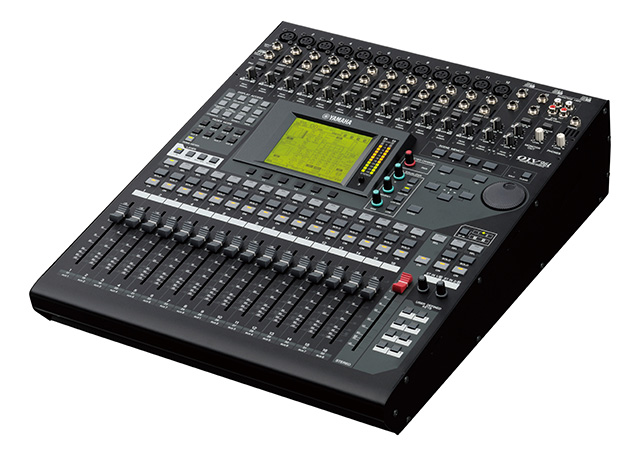
The YAMAHA 01V96i is therefore not a machine that recently has has been released on the market, but the latest version of a series of digital mixing consoles that have proven their services for decades (ProMix 01, 02R, 03D, DM 1000, DM 2000, 02R96, etc...) And from a technical point of view a 01V96i is still more than up-to-date.
I'm not going to start discussing all the technical specifications here because they are very extensive. But I can still tell you that I immediately expanded the mixing table with a YAMAHA MY8-AD96 card (this card provides 8 additional analogue inputs at 96 kHz):
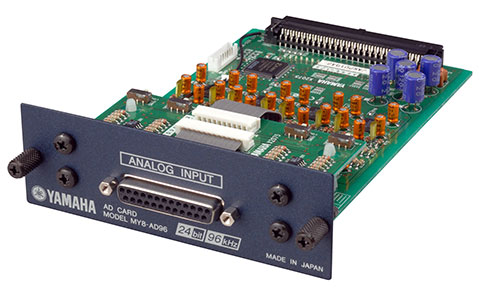
But the 01V96i also has optical ADAT connectors for another 8 additional digital inputs (and outputs), I will also use this immediately by connecting the device shown below:


Focusrite - Scarlett OctoPre
8-channel mic pre-amp with ADAT connectivity
Whoever knows me well knows I'm also a fan of Focusrite, so also the choice was easily made here too. Briefly summarized: the Focusrite Scarlett OctoPre has 8 high quality microphone pre-amps with high end AD-conversion at sample frequencies ranging from 44.1 kHz to 192 kHz.
So with the YAMAHA MY8-AD96 card and the Focusrite Scarlett OctoPre, the YAMAHA 01V96i finally has 32 analogue mono inputs (16 in stereo mode) and I have connected all the synthesizers that are permanently installed in the studio (in alphabetical order):
- Behringer DeepMind 12
- KORG MS-20
- moog Voyager
- moog SUB 37
- novation ULTRANOVA
- Roland INTEGRA-7
- Roland JD-XA
- Roland JV-1080
- Roland JV-2080
- Roland JUPITER-80
- Roland SYSTEM-8
- Roland V-Piano
- Roland V-Synth (with Roland VC-1 V-Card = Roland D-50)
- Roland V-Synth GT
- waldorf blofeld
And there is still a little room left to connect 2 additional synthesizers that are not permanently installed in the studio if necessary:
- CASIO VL TONE VL-1
- Roland D-10
- Roland D-70
- Roland JUNO-106
Many of my more recent synthesizers are also connected to the Pro Tools HD hardware via digital S/P DIF outputs, but by connecting them also analogue to the YAMAHA 01V96i, they can also be used in Logic Pro. That's because the O1V96i is directly connected to the Apple Mac Pro computer via USB. And the older digital synthesizers + analogue synthesizers without digital S/P DIF outputs are also available in Pro Tools HD via the 01V96i because the 01V96i is also connected to the Pro Tools HD hardware via the digital S/P DIF output on the 01V96i (converted to AES/EBU).
![]()
May 16, 2017
![]()
New acquisition to my synthesizer collection:

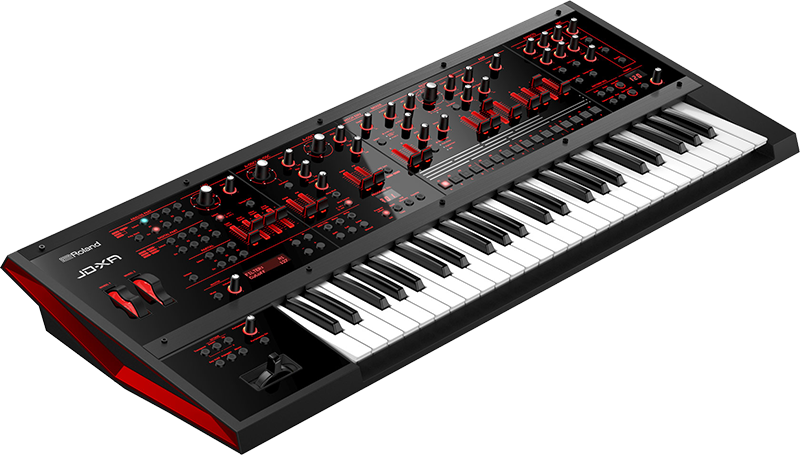
Roland - JD-XA
analogue/Digital Crossover Synthesizer
Actually, I wanted to buy this synthesizer much earlier, but the Behringer DeepMind 12 suddenly appeared on the market, thus shifting the intention to purchase the Roland JD-XA to the background (see my post of February 11, 2017 for more information about my purchase of a Behringer DeepMind 12).
It's also a Roland synthesizer just like the recently purchased SYSTEM-8, but actually the SYSTEM-8 and the JD-XA have little to nothing in common. It is even so that both machines were developed by completely separate divisions within the Roland Corporation. The System-8 was developed by the AIRA department which is also responsible for the monophonic SYSTEM-1 and SYSTEM-1m PLUG-OUT synthesizers, TR-8 Rhythm Performer, TB-3 Touch Bassline, etc... All of these machines are machines based on analogue Circuit Behavior (ACB) technology where the software mimics each analogue component from an analogue synthesizer separately.
The JD-XA, on the other hand, was developed by the department which is also responsible for the JUPITER-50, JUPITER-80 en INTEGRA-7 and these machines are based on SuperNATURAL technology. I already have a JUPITER-80 and an INTEGRA-7, so a JD-XA seems unnecessary, but nothing less is true. Actually the JD-XA is an analogue / digital crossover synthesizer with 4 analogue oscillators and filters, supplemented with a digital 64-voice SuperNATURAL engine. Those 4 analogue voices are the reason why a JD-XA is so special because the last time Roland used analogue oscillators was in 1986. And what makes it extra worthwhile is that you also can send the sound that the 64-voice SuperNATURAL engine produces through the analogue filters. This really makes a JD-XA a crossover synthesizer that really combines the possibilities of analogue and digital technology.
A Roland SYSTEM-8 and a JD-XA complement each other very well, not only in terms of sound but also in design, they are clearly family of each other, yet with a very different character.
The JD-XA also has many buttons, but not as much as the SYSTEM-8. They mainly serve the analogueue part of the JD-XA. For the digital SuperNATURAL engine, the operation is via software menu diving, just like the JUPITER-80 (but without a touch screen):
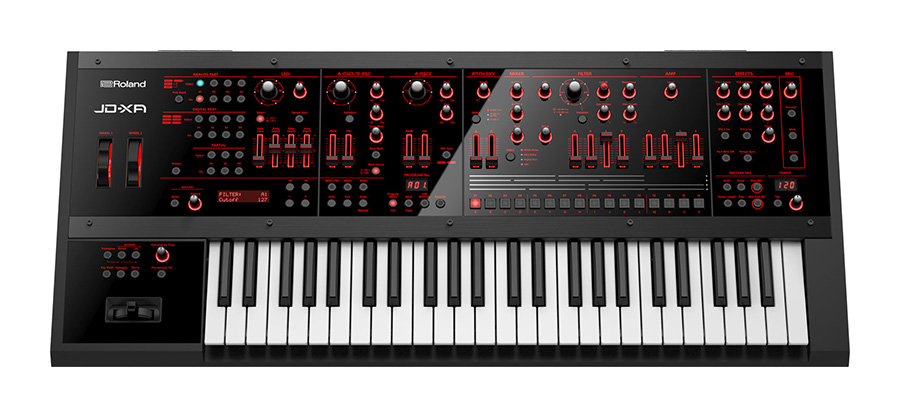
The design of the shiny black surface with red lettering is very beautiful in appearance, but in practice this surface attracts a lot of dust and is also very sensitive to fingerprints. And the red lettering next to red-illuminated LED lights makes this machine virtually unreadable in some darker environments like on stage or in a studio. But here Roland also has a solution: there are free mat black overlays available with white lettering:
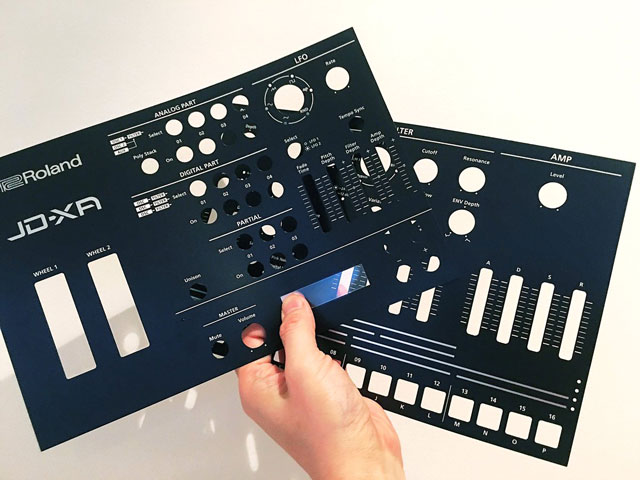
I have applied the new overlays and it is a large improvement in readability and there are no dust particles or fingerprints visible anymore.
For the Roland JD-XA there are no wood or aluminum side panels available, but I do not think it's necessary at all, because in my opinion the original sides are already very beautiful!

![]()
April 11, 2017
![]()
My birthday presents:
two new acquisitions to my synthesizer collection:

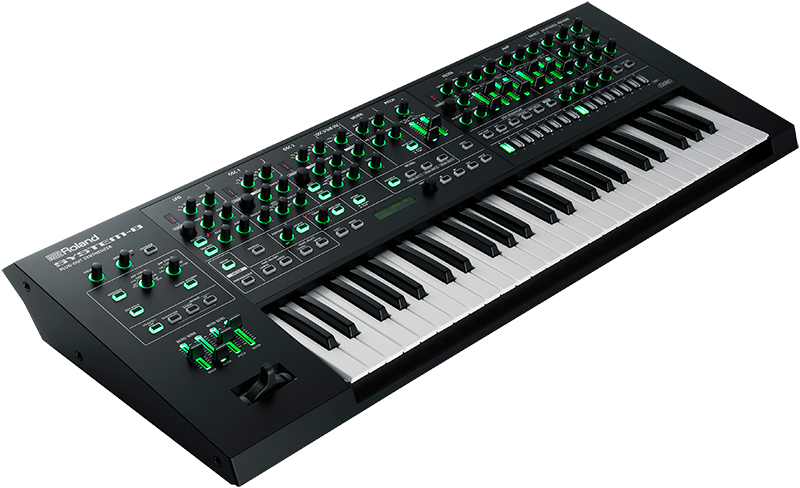
Roland - SYSTEM-8
PLUG-OUT Synthesizer
Actually, I've been dreaming for years to buy an original Roland JUPITER-8 from 1981...
This is a picture of a Roland JUPITER-8, for me it remains the most beautiful synthesizer ever existed...

Some time ago, I even saw one for sale and I had the opportunity to fulfill my dream!
But 7,500.00 euros for a machine that is over 35 years old + there is a big chance that it will not continue to function properly + spare parts are virtually untraceable? It was not a good idea after all and I have left this opportunity to pass...
But never mind, I just bought a brand new Roland SYSTEM-8, because in addition to the SYSTEM-8 engine itself ... yes... there is also a virtual Roland JUPITER-8!
And there is also a virtual Roland JUNO-106 from 1984 and you can add additional PLUG-OUTS of a Roland SH-2 and a Roland PROMARS (both from 1979), a Roland SH-101 (from 1982) or the semi-modular Roland SYSTEM-100 (from 1975). And eventually, other legendary Roland synthesizers may also become available as a PLUG-OUT.
The new SYSTEM-8 is a completely digital machine, but Roland has developed analogue Circuit Behavior (ACB) where the software mimics every analogue component from an analogue synthesizer instead of the sounds of a synthesizer in its entirety. So no samples or the like are being used,It is all about the exact digital re-creation of legendary old Roland synthesizers.
And has Roland succeeded in bringing those old machines back to life? The answer is undeniably positive. Actually, I did the test myself: I still have an original JUNO-106 from 1984 (which I recently re-calibrated completely) and I notice virtually no difference between the JUNO-106 PLUG-OUT in the SYSTEM-8 and my machine. And I hear and read the same stories of people who own an original JUPITER-8, so, in my opinion, I really have a real JUPITER-8 in the studio!
Apart from the already existing JUPITER-8 and JUNO-106 PLUG-OUTs (and the ability to load others) I also chose the SYSTEM-8 because it has more than 70 buttons. So virtually every function has its own button, just like the old analogue synthesizers, as shown in the picture below:
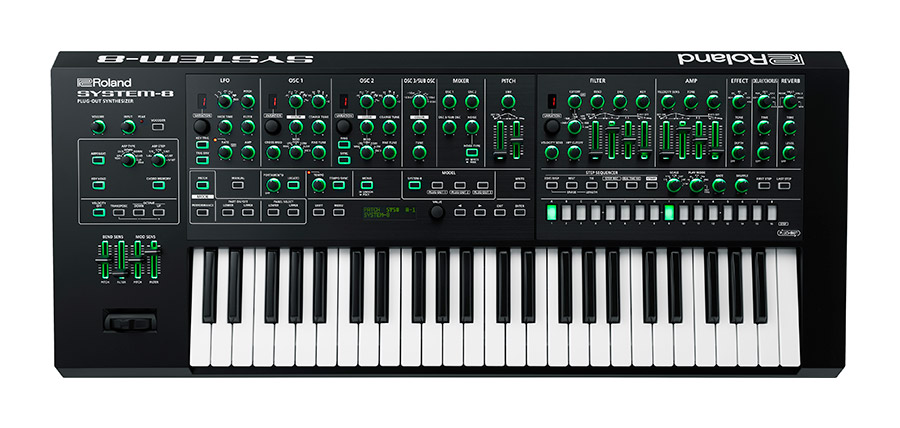
Therefore this digital synthesizer also physically acts as a true analogue synthesizer + depending on which PLUG OUT is active, only the buttons that have a function will light up in green, all others remain dark. So immediately you have a visual overview of the available buttons, which is very useful.
The black with white and green design I find somehow less successful, but Roland does provide the opportunity to make the design more appealing by mounting some side panels (these can be ordered separately). These side panels are available made out of wood or aluminum. The wood gives the machine more or less a retro look and the aluminum version provides a more high-tech look. The aluminum, of course, also clearly refers to the sides of a Roland JUPITER-8, What is of course appropriate because there is actually a JUPITER-8 PLUG-OUT present in the machine.
This is a picture of how my SYSTEM-8 really looks like: with aluminum sides:
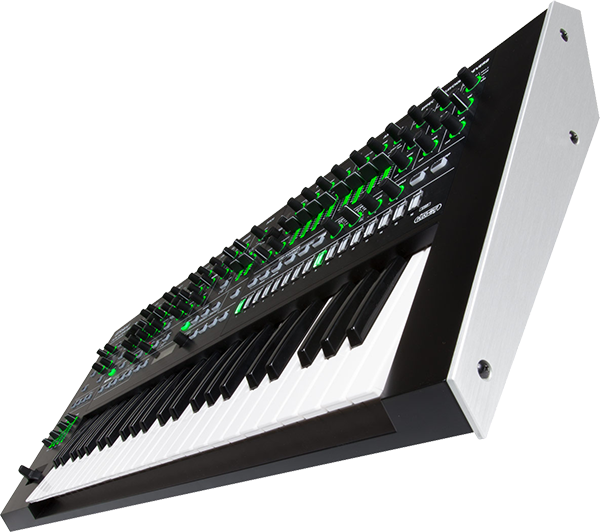
And 'Da Da Da'...
a present from the old days
'Da Da Da' with the text 'Da Da Da - Ich lieb dich nicht du liebst mich nicht - Aha Aha Aha' was a 'one hit wonder' for the band TRIO in 1981, the heyday of the Neue Deutsche Welle (DNW) with bands like Deutsch Amerikanische Freundschaft (DAF), Einstürzende Neubauten, Grauzone and of course Kraftwerk.
Anyone who has ever heard the song may not only remember the text but also the typical drum pattern (and perhaps also the synthesizer sound in the chorus). This is a link to the official YouTube video:
This legendary sound came from one of CASIO's first synthesizers, the CASIO VL-TONE VL-1.

VL-TONE VL-1

It was launched in 1981 and was the first CASIO synthesizer with a melody memory (real-time sequencer). The device is only 30 cm. long and 7.5 cm. wide, 1/5 of the device is occupied by the built-in speaker and another 1/5th by the battery compartment. So, in fact, the electronics are much smaller than it seems to be at first sight. It was designed by the Japanese company CASIO as the first real portable synthesizer with which you could make music sitting on a little bench and you could also record the melody. Anyway, the CASIO VL-1 has featured the era of the typical Japanese technological gadgets where the country is now so famous for.
It's truly a completely analogue, monophonic synthesizer that was already digitally controlled by some kind of refined CASIO calculator (you can also use the VL-1 as a calculator as well).The device has 10 built-in rhythm patterns composed of only 3 sounds and 6 built-in preset sounds (one of which also has an ADSR function). This machine was used in many recordings by bands and artists from them and now like The Human League, Vince Clark, Talking Heads, Thomas Dolby, Robbie Williams, Sting, Stevie Wonder, Beastie Boys, Apollo 440, Lady Gaga, etc...
The CASIO VL-TONE VL-1 has therefore acquired a true cult status, there is even one exhibited in the Technisches Museum Wien (Vienna Technology Museum) in Vienna:
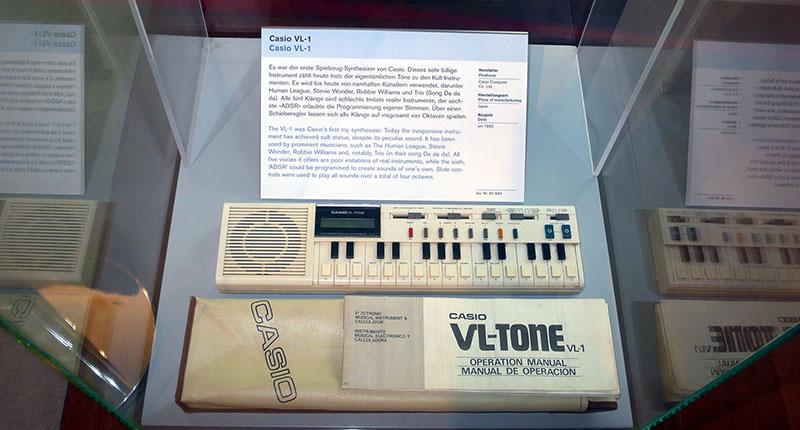
An original CASIO VL-TONE VL-1 is more and more difficult to find and also relatively expensive to buy. The copy of released by Tandy (Realistic Concertmate 200) will show up more easily at cheaper prices. But a few weeks ago I was searching on websites with second hand equipment and suddenly I found an original CASIO VL-TONE VL-1 at a very interesting price. So I did not hesitate long and bought the little device. Once received, the housing appeared to be yellowed by age and was also very dirty and dusty. But after thorough cleaning and technical inspection it appears that the machine is still working well and sounds very good, both via the loudspeakers and via the mono line output, aha aha aha!
So... From now on also available in the studio: an authentic CASIO VL-TONE VL-1 from 1981.
![]()
April 10, 2017
![]()
Today I celebrate my birthday!
I am 18 + 32 years of experience = 50!
Completely original "vintage" model from 1967
with all original components!
Expanded with 5 additional components, professionally installed in the coronary arteries
and made of
100% pure titanium!

Photo was taken on April 9, 2017
![]()
April 01, 2017
![]()
In memoriam
Ikutaro Kakehashi
February 07, 1930 - April 01, 2017

I suppose the name Ikutaro Kakehashi will sound net very familiar for most people, but in 1972 he founded the company Roland Corporation in Osaka (Japan). He was responsible for the development of many legendary electronic drum machines and synthesizers and in 1983 he was also responsible for the development of MIDI (Musical Instruments Digital Interface), the standard protocol that allows electronic musical instruments to communicate with each other.
Over the years I have owned many Roland instruments and equipment, currently I have the following machines present and working in the studio (ordered by age):
- Roland - JUNO-106 - Programmable Polyphonic Synthesizer (vintage 1984)
- Roland - DEP-5 - Digital Effects Processor (vintage 1986)
- Roland - DEP-3 - Digital Effects Processor (vintage 1987)
- Roland - D-50 - Linear Synthesizer (vintage 1987) (= actually a Roland VC-1 V-Card for the Roland V-Synth)
- Roland - D-10 - Multi Timbral Linear Synthesizer (vintage 1988)
- Roland - D-70 - Super LA Synthesizer (1990)
- Roland - JV-1080 - Super JV 64 voice Synthesizer Module (1994)
- Roland - JV-2080 - 64 voice Synthesizer Module (1997)
- Roland - V-Synth (2003)
- Roland - FC-200 - MIDI Foot Controller (2005)
- Roland - V-Synth GT - Dual-core V-Synth with AP Synthesis and Vocal Designer (2007)
- Roland - V-Piano (2009)
- Roland - JUPITER-80 - SuperNATURAL Synthesizer (2011)
- Roland - INTEGRA-7 - SuperNATURAL Sound Module (2012)
- Roland - V-Drums - V-Pro® Series - TD-50 KV (extended) (2016)
Without Ikutaro Kakehashi the list above would not have existed and perhaps even my studio would never had existed.
I have seen the man several times at the Musikmesse in Frankfurt, but I have never really met him.
I can only express my greatest respect and say goodbye Ikutaro Kakehashi, a man who has been indirectly very important to my musical development and the development of my studio in general.
![]()
February 11, 2017
![]()
And also this beautiful analogue synthesizer is
finally present at Delta Music Belgium
(and again probably the first recording studio in the Benelux)
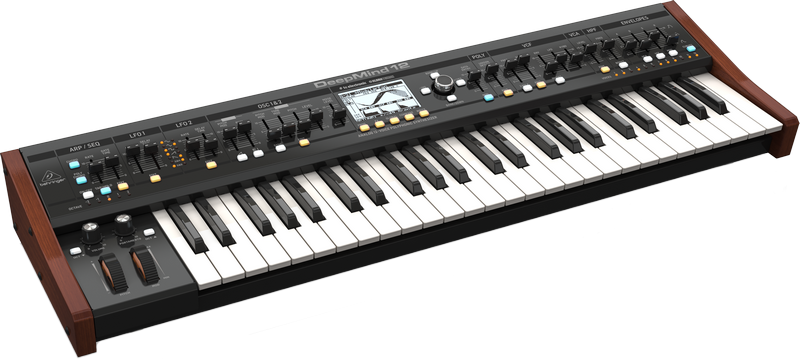
Behringer - DeepMind 12
True analogue 12-Voice Polyphonic Synthesizer
There was already written a lot about this machine on specialized forums... It is currently only available in Germany and in the USA because two major music stores immediately bought all the available stock... In the Benelux we still have to wait more than two months until the first units will be available... So this must surely be a very special synthesizer, no?
And it is indeed no ordinary synthesizer, but actually it is, because he goes back to the first analogue polyphonic synthesizers from the 80s!
Today there are many 'virtual analogue' polyphonic synthesizers on the market, where one tries to mimic the classic analogue electronics in a digital way. This certainly does not have to be bad, on the contrary, but for the DeepMind 12 Behringer has specifically chosen to design a synthesiizer with a true anolog signal path, just like in the old days, buth with contemporary electronic components and also entirely digitally controlled.
Actually, the goal was to create a copy of the legendary Roland JUNO-106, a copy of modern days. As modern electronic components are much smaller than 30 years ago it proved possible to double the polyphony of the JUNO-106 (which is 6 voices) to a stunning 12 voices. As a matter of fact there exist very few 12-voice analogue synthesizers, they are also very expensive and usually very large in size and weight. None of this at Behringer: 12 analogue voices in a small housing with all the necessary buttons and faders, combined with lots of extra features and, thanks to mass production in China, also considerably cheaper than today's 'virtual analogue' polyphonic synthesizer, it is amazing...
And then you have to know this is the first synthesizer Behringer releases on the market. And according to well-informed sources, this will certainly not be the last release, because given the great success of this first attempt Behringer plans to copy even more ancient, legendary synthesizers. Besides, the DeepMind 12 design team is very reputable, it are the people behind legendary names such as Midas, Klark Teknik and TC Electronic (which is not difficult to explain if you know that Behringer has bought all these companies).
BTW, it is not entirely unexpected to see Behringer releasing a synthesizer, because Uli Behringer, CEO and founder of Behringer, already built a synthesizer himself in 1977 at the age of 16, it was the UB-1 synthesizer. This is a photo of the UB-1 from the old days:

And of course there still is the most important question that needs to be answered: how does new Behringer Deep Mind 12 sound like?
Of course i can compare the Deep Mind 12 with the original, because I still have an original Roland JUNO-106 from 1984 in my possession. And indeed, I can confirm that they are very close to each other in terms of basic sound. But at the same time the DeepMind 12 does go a whole lot further then the JUNO-106 ever did.
This has two main reasons: first and foremost, it has 12 voices, so basically you have two JUNO-106 synthesizers in one housing. And secondly, it has four extensive digital effects processor (reverb, delay, etc...) and a JUNO-106 has not (but a JUNO-106 does have a very nice analogue chorus that is not available in the DeepMind 12). And the DeepMind 12 also has an 8-bus modulation matrix, an arpeggiator, a 32-step sequencer, a touch sensitive keyboard with aftertouch, 1024 memory banks, built-in WiFi,controllable by iPad or tablet, etc.... A Deep Mind 12 can therefore sound old, very analogue, warm and full, but also very modern, harsh and agressive.
Personally, I am a big fan of warm, wide and lush pads and the Deep Mind 12 is really fantastic for this. You can distribute all 12 analogue oscillators over the stereo image, slightly detune them and before you know it... you will be on analogue cloud nine!
But also the new digital techniques are very impressive and not only the four most extensive digital effects processors. To give an example: a few weeks ago, I have recalibrated my old Roland JUNO-106 to the original factory specifications. This is a very cumbersome analogue procedure, for this you need a frequency counter, a high-resolution mulitmeter, an oscilloscope, an extensive service manual and especially a lot of time and patience. The modern Deep Mind 12 can calibrate itself automatically (with 12 analogue signal paths instead of 6 on the JUNO-106), you just have to wait an hour and it's finished, that's called technical progress!
And here's a picture of this beautiful analogue synthesizer in the studio (I find the design very successful):
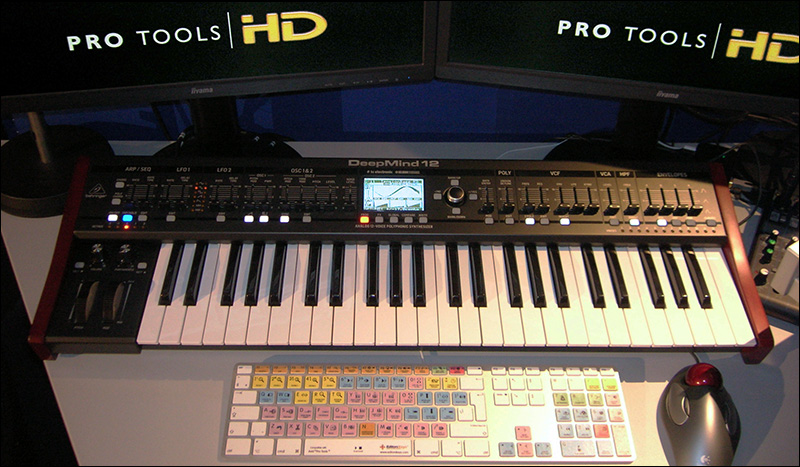
![]()
January 28, 2017
![]()
Finally present at Delta Music Belgium
(and probably the first recording studio in the Benelux)
Roland - TD-50KV - V-Pro Series 'Prismatic Sound Modeling' V-Drums Electronic Drum Kit
After having to wait for the parts for a long time (they were ordered late September 2016) our already to its maximum extended Roland TD-30KV was finally upgraded for a TD 50kV (which was also extended to its maximum capacity).
This is a picture of the TD-50KV from the Roland website:
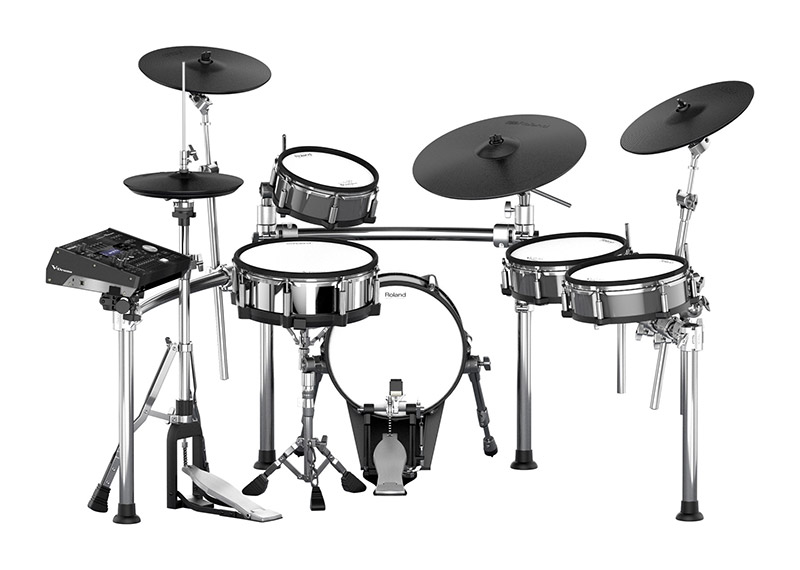
This is a picture of my complete V-Drums kit in the 'Roland V-Drums Room':
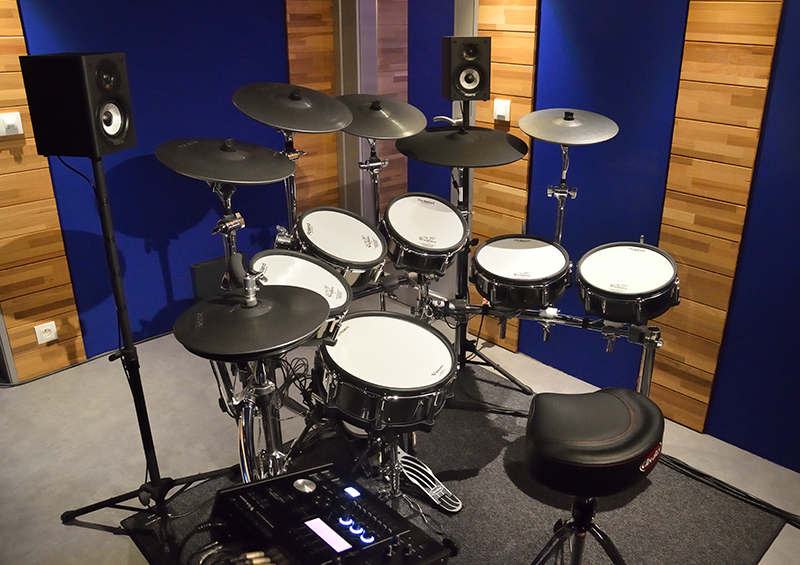
This is my actual V-Drums configuration:
- 1 x TD-50 - 'Prismatic Sound Modeling' Drum sound module
- 1 x V-Kick 14" Kick drum: KD-140-BC (black chrome)
- 1 x V-Pad 14" DIGITAL Snare: PD-140DS (silver)
- 3 x V-Pad 10" Tom: PD-108-BC (black chrome)
- 2 x V-Pad 12" Tom: PD-128-BC (black chrome)
- 1 x V-Hi-Hat 13" Hi-Hat: VH-13-MG (metallic gray)
- 4 x V-Cymbal 14" Crash Cymbal: CY-14C-MG (metallic gray)
- 1 x V-Cymbal DIGITAL 18" Ride Cymbal: CY-18DR (black)
- 1 x BT-1 Bar Trigger Pad
- 1 x V-Drums Stand - MDS-25
- 1 x V-Drums Mat - TDM-20
There is also available a TD-50KV with KD-A22 Kick Drum Converter instead of a V-Kick KD-140-BC 14" bass drum pad:
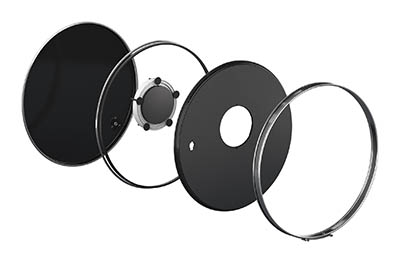
You can mount this converter on a standard 22" bass drum shell and it turns it into a V-Kick. But this is primarily intended to be used live on a stage to enable you to place a big bass drum which then has a purely visual function, as seen in the picture below:
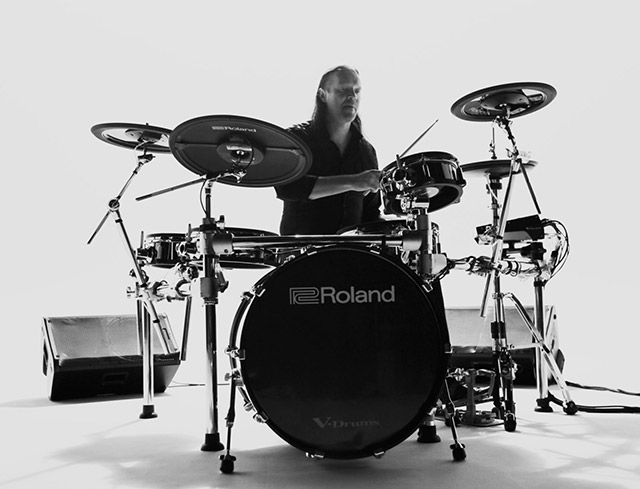
But for studio work a pseudo 22 "bass drum makes absolutely no sense and would just take up additional space. That is why I have chosen not tot buy this KD-A22 Kick Drum Converter + a 22" bass drum shell, also because I am very satisfied with the V-Kick KD-140-BC bass drum pad.
The main differences between the previous TD-30KV and the new TD-50KV are the new TD-50 module with drum sounds generated by 'Prismatic Sound Modeling', the new V-Pad PD-140DS 14" digital snare drum and the new V-Cymbal CY-18DR 18" digital ride cymbal. Obviously a snare drum and a ride cymbal are the two most important components of a drum kit and just those parts have been given a major upgrade. On the one hand by making them digital connected via USB with much more internal sensors and by increasing them in size to to a standard 14" snare drum and a standard 18" ride cymbal (on the TD-30KV this was 12" snare drum and 15" ride cymbal). The result is a much better and more realistic playing sensation making the difference with a real drum again a lot smaller.
Actually, visually my TD-50KV is a hybrid between my original TD-30KV with its metallic gray versions of the 13" hi-hat + 14" cymbals and a TD-50KV with its black 18" digital ride cymbal (a TD-50KV has black cymbals) + its silver 14" digital snare drum (both kits come with black chrome toms). Technically this is 100% a full blown TD-50KV expanded to it's maximum capacity.
I have the TD-50KV parts present in the studio for a week know and I have to admit that there is a big difference in playing on this kit and in playing playing on my previous TD-30KV. Indeed the larger snare drum and ride cymbal + their higher sensitivity make playing this kit much more realistic and enjoyable. And the brand new 'Prismatic Sound Modeling' in the TD-50 module is also a nice improvement, eg. the typical 'machine gun' effect when playing on electronic drums has disappeared almost completely + now you can also load custom drum samples into the module and layer them with the internal sounds for truly unlimited sound possibilities, very nice!
More info about my Roland V-Drums can be found at:
![]()

![]()
![]()
Copyright © 1995-2025 by Delta Music Belgium • Dolby Atmos Music Studio • Rummenweg 30 • 3800 Sint-Truiden • Belgium
All Rights Reserved
Privacy notification and cookie policy
All product names, logos, and brands are property of their respective owners.
All company, product and service names used on this website are for identification purposes only.
Use of these names, logos, and brands does not imply endorsement.
![]()
